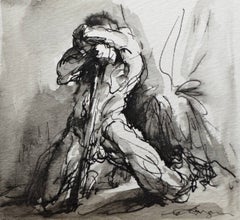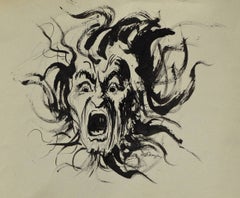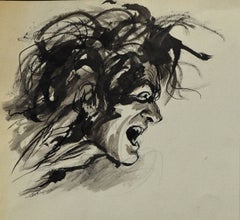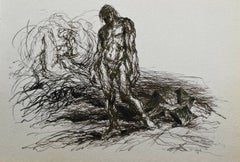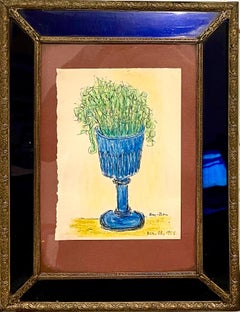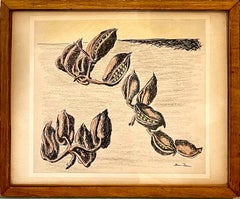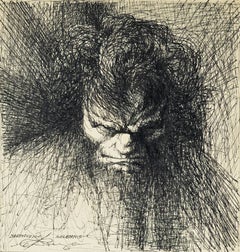Gustav Rehberger Figurative Drawings and Watercolors
Austrian, 1910-1995
Gustav Rehberger was an Austrian-born American painter, draftsman, illustrator, designer, muralist and art educator. Rehberger is represented by Trigg Ison Fine Art, West Hollywood, California. He had solo shows at the Carnegie Hall Museum Benefit in 1992, Pompeii Museum, Monica North Galleries in 1992, Jacques Seligmann Gallery in New York City in 1977 and many others.
4
3
1
4
Overall Height
to
Overall Width
to
4
4
4
4
2
1
1
1
4
2
2
19
671
326
198
132
4
Artist: Gustav Rehberger
Planting the Stake
By Gustav Rehberger
Located in West Hollywood, CA
We are proud to present a just arrived series of original pen and ink and ink wash drawings by Austrian/American artist Gustav Rehberger. These works were acquired directly from the ...
Category
1970s Expressionist Gustav Rehberger Figurative Drawings and Watercolors
Materials
Ink
The Scream
By Gustav Rehberger
Located in West Hollywood, CA
We are proud to present a just arrived series of original pen and ink and ink wash drawings by Austrian/American artist Gustav Rehberger. These works were acquired directly from the personal collection of the artist and family.
"The Scream...
Category
1940s Expressionist Gustav Rehberger Figurative Drawings and Watercolors
Materials
Ink
The Scream #1
By Gustav Rehberger
Located in West Hollywood, CA
We are proud to present a just arrived series of original pen and ink and ink wash drawings by Austrian/American artist Gustav Rehberger. These works were acquired directly from the personal collection of the artist and family.
"The Scream...
Category
1940s Expressionist Gustav Rehberger Figurative Drawings and Watercolors
Materials
Ink
Man and the Mountain
By Gustav Rehberger
Located in West Hollywood, CA
We are proud to present a just arrived series of original pen and ink and ink wash drawings by Austrian/American artist Gustav Rehberger. These works were acquired directly from the ...
Category
1970s Expressionist Gustav Rehberger Figurative Drawings and Watercolors
Materials
Ink
Related Items
Expressionist Color Drawing Cobalt Glass Vintage Frame Modernist Ben Zion WPA
By Ben-Zion Weinman
Located in Surfside, FL
Expressionist ink and pastel crayon drawing of flowers in vase.
Framed in a vintage cobalt blue glass original frame
Hand signed and dated
Framed it measures 13.5 X 10.5
The actual paper is 7.5 X 5.5
Born in 1897, Ben-Zion Weinman celebrated his European Jewish heritage in his visual works as a sculptor, painter, and printmaker. Influenced by Spinoza, Knut Hamsun, and Wladyslaw Reymont, as well as Hebrew literature, Ben-Zion wrote poetry and essays that, like his visual work, attempt to reveal the deep “connection between man and the divine, and between man and earth.” An emigrant from the Ukraine, he came to the US in 1920. He wrote fairy tales and poems in Hebrew under the name Benzion Weinman, but when he began painting he dropped his last name and hyphenated his first, saying an artist needed only one name.
Ben-Zion was a founding member of “The Ten: An Independent Group” The Ten” a 1930’s avant-garde group, Painted on anything handy. Ben-Zion often used cabinet doors (panels) in his work. Other members of group included Ilya Bolotowsky, Lee Gatch, Adolph Gottlieb, Louis Harris, Yankel Kufeld, Marcus Rothkowitz (later known as Mark Rothko), Louis Schanker, and Joseph Solman. The Art of “The Ten” was generally described as expressionist, as this style offered the best link between modernism and social art. Their exhibition at the Mercury Gallery in New York held at the same time as the Whitney Annual Exhibition of Contemporary American Painting, included a manifesto concentrating on aesthetic questions and criticisms of the conservative definition of modern art imposed by the Whitney. Ben-Zion’s work was quickly noticed. The New York Sun said he painted “furiously” and called him “the farthest along of the lot.” And the triptych, “The Glory of War,” was described by Art News as “resounding.”
By 1939, The Ten disbanded because most of the members found individual galleries to represent their work. Ben-Zion had his first one-man show at the Artist’s Gallery in Greenwich Village and J.B. Neumann, the highly esteemed European art dealer who introduced Paul Klee, (among others) to America, purchased several of Ben-Zion’s drawings. Curt Valentin, another well-known dealer, exhibited groups of his drawings and undertook the printing of four portfolios of etchings, each composed of Ben-Zion’s biblical themes. He worked as a WPA artist.
Ben-Zion’s work is represented in many museums throughout the country including the Metropolitan, the Whitney, and the Museum of Modern Art in New York, the Art Institute of Chicago, the Philadelphia Museum of Art and the Phillips Collection, Washington. The Jewish Museum in New York opened in 1948 with a Ben-Zion exhibition.
Ben-Zion consistently threaded certain subject matter—nature, still life, the human figure, the Hebrew Bible, and the Jewish people—into his work throughout his life. "In all his work a profound human feeling remains. Sea and sky, even sheaves of wheat acquire a monolithic beauty and simplicity which delineates the transient as a reflection of the eternal. This sensitive inter- mingling of the physical and metaphysical is one of the most enduring features of Ben-Zion's works." (Excerpt from Stephen Kayser, “Biblical Paintings,” The Jewish Museum Catalogue, 1952). Mystical Imprints: Marc Chagall, Ben-Zion, and Ben Shahn presents the print work of three prominent 20th century Jewish artists born in the Russian Empire. Among these seventy pieces are etchings and lithographs from Chagall’s Bible series...
Category
1950s Expressionist Gustav Rehberger Figurative Drawings and Watercolors
Materials
Paper, Oil Crayon, Pastel, Ink
Expressionist Ink, Pastel, Crayon Drawing Jewish American Modernist Ben Zion WPA
By Ben-Zion Weinman
Located in Surfside, FL
Expressionist ink and pastel crayon drawing of beans (carobs, flowers?) in pods
Hand signed.
Born in 1897, Ben-Zion Weinman celebrated his European Jewish heritage in his visual works as a sculptor, painter, and printmaker. Influenced by Spinoza, Knut Hamsun, and Wladyslaw Reymont, as well as Hebrew literature, Ben-Zion wrote poetry and essays that, like his visual work, attempt to reveal the deep “connection between man and the divine, and between man and earth.” An emigrant from the Ukraine, he came to the US in 1920. He wrote fairy tales and poems in Hebrew under the name Benzion Weinman, but when he began painting he dropped his last name and hyphenated his first, saying an artist needed only one name.
Ben-Zion was a founding member of “The Ten: An Independent Group” The Ten” a 1930’s avant-garde group, Painted on anything handy. Ben-Zion often used cabinet doors (panels) in his work. Other members of group included Ilya Bolotowsky, Lee Gatch, Adolph Gottlieb, Louis Harris, Yankel Kufeld, Marcus Rothkowitz (later known as Mark Rothko), Louis Schanker, and Joseph Solman. The Art of “The Ten” was generally described as expressionist, as this style offered the best link between modernism and social art. Their exhibition at the Mercury Gallery in New York held at the same time as the Whitney Annual Exhibition of Contemporary American Painting, included a manifesto concentrating on aesthetic questions and criticisms of the conservative definition of modern art imposed by the Whitney. Ben-Zion’s work was quickly noticed. The New York Sun said he painted “furiously” and called him “the farthest along of the lot.” And the triptych, “The Glory of War,” was described by Art News as “resounding.”
By 1939, The Ten disbanded because most of the members found individual galleries to represent their work. Ben-Zion had his first one-man show at the Artist’s Gallery in Greenwich Village and J.B. Neumann, the highly esteemed European art dealer who introduced Paul Klee, (among others) to America, purchased several of Ben-Zion’s drawings. Curt Valentin, another well-known dealer, exhibited groups of his drawings and undertook the printing of four portfolios of etchings, each composed of Ben-Zion’s biblical themes. He worked as a WPA artist.
Ben-Zion’s work is represented in many museums throughout the country including the Metropolitan, the Whitney, and the Museum of Modern Art in New York, the Art Institute of Chicago, the Philadelphia Museum of Art and the Phillips Collection, Washington. The Jewish Museum in New York opened in 1948 with a Ben-Zion exhibition.
Ben-Zion consistently threaded certain subject matter—nature, still life, the human figure, the Hebrew Bible, and the Jewish people—into his work throughout his life. "In all his work a profound human feeling remains. Sea and sky, even sheaves of wheat acquire a monolithic beauty and simplicity which delineates the transient as a reflection of the eternal. This sensitive inter- mingling of the physical and metaphysical is one of the most enduring features of Ben-Zion's works." (Excerpt from Stephen Kayser, “Biblical Paintings,” The Jewish Museum Catalogue, 1952). Mystical Imprints: Marc Chagall, Ben-Zion, and Ben Shahn presents the print work of three prominent 20th century Jewish artists born in the Russian Empire. Among these seventy pieces are etchings and lithographs from Chagall’s Bible series...
Category
Mid-20th Century Expressionist Gustav Rehberger Figurative Drawings and Watercolors
Materials
Paper, Oil Crayon, Pastel, Ink
Pastel, Ink Drawing Rocks And Cloud Landscape Jewish American Modernist WPA
By Ben-Zion Weinman
Located in Surfside, FL
Miniature Landscape
Provenance: Virginia Field, Arts administrator; New York, N.Y. Assistant director for Asia House gallery. (she was friends with John von Wicht and Andy Warhol)
Born in 1897, Ben-Zion Weinman celebrated his European Jewish heritage in his visual works as a sculptor, painter, and printmaker. Influenced by Spinoza, Knut Hamsun, and Wladyslaw Reymont, as well as Hebrew literature, Ben-Zion wrote poetry and essays that, like his visual work, attempt to reveal the deep “connection between man and the divine, and between man and earth.”
An emigrant from the Ukraine, he came to the US in 1920. He wrote fairy tales and poems in Hebrew under the name Benzion Weinman, but when he began painting he dropped his last name and hyphenated his first, saying an artist needed only one name.
Ben-Zion was a founding member of “The Ten: An Independent Group” The Ten” a 1930’s avant-garde group, Painted on anything handy. Ben-Zion often used cabinet doors (panels) in his work. Other members of group included Ilya Bolotowsky, Lee Gatch, Adolf Gottlieb, Louis Harris, Yankel Kufeld, Marcus Rothkowitz (later known as Mark Rothko), Louis Schanker, and Joseph Solman. The Art of “The Ten” was generally described as expressionist, as this style offered the best link between modernism and social art. Their exhibition at the Mercury Gallery in New York held at the same time as the Whitney Annual Exhibition of Contemporary American Painting, included a manifesto concentrating on aesthetic questions and criticisms of the conservative definition of modern art imposed by the Whitney. Ben-Zion’s work was quickly noticed. The New York Sun said he painted “furiously” and called him “the farthest along of the lot.” And the triptych, “The Glory of War,” was described by Art News as “resounding.”
By 1939, The Ten disbanded because most of the members found individual galleries to represent their work. Ben-Zion had his first one-man show at the Artist’s Gallery in Greenwich Village and J.B. Neumann, the highly esteemed European art dealer who introduced Paul Klee, (among others) to America, purchased several of Ben-Zion’s drawings. Curt Valentin, another well-known dealer, exhibited groups of his drawings and undertook the printing of four portfolios of etchings, each composed of Ben-Zion’s biblical themes.
Ben-Zion’s work is represented in many museums throughout the country including the Metropolitan, the Whitney, and the Museum of Modern Art in New York, the Art Institute of Chicago, the Philadelphia Museum of Art and the Phillips Collection, Washington. The Jewish Museum in New York opened in 1948 with a Ben-Zion exhibition.
“Ben-Zion has his hands on the pulse of the common man and his natural world”
As he emerged as an artist Ben-Zion never lost his gift for presenting the ordinary in ways that are vital, fresh and filled with emotions that are somber and exhilarating, joyous and thoughtful, and ultimately, filled with extraordinary poetic simplicity.
Ben-Zion consistently threaded certain subject matter—nature, still life, the human figure, the Hebrew Bible, and the Jewish people—into his work throughout his life. "In all his work a profound human feeling remains. Sea and sky, even sheaves of wheat acquire a monolithic beauty and simplicity which delineates the transient as a reflection of the eternal. This sensitive inter- mingling of the physical and metaphysical is one of the most enduring features of Ben-Zion's works." (Excerpt from Stephen Kayser, “Biblical Paintings,” The Jewish Museum Catalogue, 1952).
Along with ben Shahn, William Gropper, Chaim Gross and Abraham Rattner he was an influential mid century Jewish American...
Category
Mid-20th Century Expressionist Gustav Rehberger Figurative Drawings and Watercolors
Materials
Pastel, Ink, Watercolor
Self Portrait
By Lester Johnson
Located in New York, NY
Lester Johnson Self Portrait 1969 drawn with ink, crayon, and spray enamel on paper. Measuring 14 by 11 inches, this drawing was recently professionally framed.
Category
1960s Expressionist Gustav Rehberger Figurative Drawings and Watercolors
Materials
Enamel
Dance Of The Sun Ray
By Gail Foster
Located in Chattahoochee Hills, GA
Dance Of The Sun Ray is a more recent edition of sepia ink drawing from one Gail Foster's most popular series.
A rare and visceral artist, Gail Foster’s works are passionately expre...
Category
21st Century and Contemporary Expressionist Gustav Rehberger Figurative Drawings and Watercolors
Materials
Ink, Paper
Original German Expressionist Drawing Ernst Ludwig Kirchner Women Dancing
By Ernst Ludwig Kirchner
Located in Surfside, FL
Ernst Ludwig Kirchner ( Germany 1880-1938 )
Expressionist Female Women Dancing Mixed Media on Paper Drawing or Painting Expressionism
Dimensions: 20" L 16" H in
This bore a sticker from Christies auction house and another collection sticker verso but they have been inadvertently removed. I do have the photo.
Ernst Ludwig Kirchner (1880 – 1938) was a German expressionist painter and printmaker and one of the founders of the artists group Die Brücke or "The Bridge", a key group leading to the foundation of Expressionism in 20th-century art. He volunteered for army service in the First World War, but soon suffered a breakdown and was discharged. His work was branded as "Entartete Kunst" or "degenerate" by the Nazis in 1933, and in 1937 more than 600 of his works were sold or destroyed.
Ernst Ludwig Kirchner was born in Aschaffenburg, Bavaria. His parents were of Prussian descent and his mother was a descendant of the Huguenots, a fact to which Kirchner often referred. As Kirchner's father searched for a job, the family moved frequently and Kirchner attended schools in Frankfurt and Perlen until his father earned the position of Professor of Paper Sciences at the College of technology in Chemnitz, where Kirchner attended secondary school. Although Kirchner's parents encouraged his artistic career they also wanted him to complete his formal education so in 1901, he began studying architecture at the Königliche Technische Hochschule (royal technical university) of Dresden. The institution provided a wide range of studies in addition to architecture, such as freehand drawing, perspective drawing and the historical study of art. While in attendance, he became close friends with Fritz Bleyl, whom Kirchner met during the first term. They discussed art together and also studied nature, having a radical outlook in common. Kirchner continued studies in Munich from 1903 to 1904, returning to Dresden in 1905 to complete his degree.
In 1905, Kirchner, along with Bleyl and two other architecture students, Karl Schmidt-Rottluff and Erich Heckel, founded the artists group Die Brücke ("The Bridge") later to include Emil Nolde, Max Pechstein and Otto Mueller. From then on, he committed himself to art. The group aimed to eschew the prevalent traditional academic style and find a new mode of artistic expression, which would form a bridge (hence the name) between the past and the present. They responded both to past artists such as Albrecht Dürer, Matthias Grünewald and Lucas Cranach the Elder, as well as contemporary international avant-garde movements. As part of the affirmation of their national heritage, they revived older media, particularly woodcut or woodblock prints.
Kirchner's studio became a venue which overthrew social conventions to allow casual love-making and frequent nudity. Group life-drawing sessions took place using nude models from the social circle, rather than professionals, and choosing quarter-hour poses to encourage spontaneity. In 1911, he moved to Berlin, where he founded a private art school, MIUM-Institut, in collaboration with Max Pechstein with the aim of promulgating "Moderner Unterricht im Malen" (modern teaching of painting). This was not a success and closed the following year, when he also began a relationship with Erna Schilling that lasted the rest of his life. In 1917, at the suggestion of Eberhard Grisebach [de], Helene Spengler invited Kirchner to Davos where he viewed an exhibition of Ferdinand Hodler paintings. "When I was leaving, I thought of Vincent Van Gogh's fate and thought that it would be his as well, sooner or later. Only later will people understand and see how much he has contributed to painting".
In 1921 Kirchner visited Zurich at the beginning of May and met the dancer, Nina Hard, whom he invited back to Frauenkirch (despite Erna's objections). Nina Hard would become an important model for Kirchner and would be featured in many of his works. Kirchner began creating designs for carpets which were then woven by Lise Gujer.
In 1925, Kirchner became close friends with fellow artist, Albert Müller...
Category
Early 20th Century Expressionist Gustav Rehberger Figurative Drawings and Watercolors
Materials
Ink, Paper
Expressionist Miniature Drawing Wheat Stalks American Modernist Ben Zion WPA
By Ben-Zion Weinman
Located in Surfside, FL
Expressionist ink drawing of wheat stalks
There is an inscription "Happy New Year" on verso
Hand signed
Framed it measures 7.75 X 5.75
The actual paper is 3 X 3.5
Born in 1897, Ben-Zion Weinman celebrated his European Jewish heritage in his visual works as a sculptor, painter, and printmaker. Influenced by Spinoza, Knut Hamsun, and Wladyslaw Reymont, as well as Hebrew literature, Ben-Zion wrote poetry and essays that, like his visual work, attempt to reveal the deep “connection between man and the divine, and between man and earth.” An emigrant from the Ukraine, he came to the US in 1920. He wrote fairy tales and poems in Hebrew under the name Benzion Weinman, but when he began painting he dropped his last name and hyphenated his first, saying an artist needed only one name.
Ben-Zion was a founding member of “The Ten: An Independent Group” The Ten” a 1930’s avant-garde group, Painted on anything handy. Ben-Zion often used cabinet doors (panels) in his work. Other members of group included Ilya Bolotowsky, Lee Gatch, Adolph Gottlieb, Louis Harris, Yankel Kufeld, Marcus Rothkowitz (later known as Mark Rothko), Louis Schanker, and Joseph Solman. The Art of “The Ten” was generally described as expressionist, as this style offered the best link between modernism and social art. Their exhibition at the Mercury Gallery in New York held at the same time as the Whitney Annual Exhibition of Contemporary American Painting, included a manifesto concentrating on aesthetic questions and criticisms of the conservative definition of modern art imposed by the Whitney. Ben-Zion’s work was quickly noticed. The New York Sun said he painted “furiously” and called him “the farthest along of the lot.” And the triptych, “The Glory of War,” was described by Art News as “resounding.”
By 1939, The Ten disbanded because most of the members found individual galleries to represent their work. Ben-Zion had his first one-man show at the Artist’s Gallery in Greenwich Village and J.B. Neumann, the highly esteemed European art dealer who introduced Paul Klee, (among others) to America, purchased several of Ben-Zion’s drawings. Curt Valentin, another well-known dealer, exhibited groups of his drawings and undertook the printing of four portfolios of etchings, each composed of Ben-Zion’s biblical themes. He worked as a WPA artist.
Ben-Zion’s work is represented in many museums throughout the country including the Metropolitan, the Whitney, and the Museum of Modern Art in New York, the Art Institute of Chicago, the Philadelphia Museum of Art and the Phillips Collection, Washington. The Jewish Museum in New York opened in 1948 with a Ben-Zion exhibition.
Ben-Zion consistently threaded certain subject matter—nature, still life, the human figure, the Hebrew Bible, and the Jewish people—into his work throughout his life. "In all his work a profound human feeling remains. Sea and sky, even sheaves of wheat acquire a monolithic beauty and simplicity which delineates the transient as a reflection of the eternal. This sensitive inter- mingling of the physical and metaphysical is one of the most enduring features of Ben-Zion's works." (Excerpt from Stephen Kayser, “Biblical Paintings,” The Jewish Museum Catalogue, 1952). Mystical Imprints: Marc Chagall, Ben-Zion, and Ben Shahn presents the print work of three prominent 20th century Jewish artists born in the Russian Empire. Among these seventy pieces are etchings and lithographs from Chagall’s Bible series...
Category
1950s Expressionist Gustav Rehberger Figurative Drawings and Watercolors
Materials
Ink
Street Life New York - Haunting Faces Windows Expressionism Mid-Century
By Lawrence Kupferman
Located in Miami, FL
Mid-century artist Lawrence Kupferman paints a madly eerie New York street scene. An exaggerated upward view of two 19th-century walk-ups is split by a forced perspective of a downwa...
Category
1940s Expressionist Gustav Rehberger Figurative Drawings and Watercolors
Materials
Ink, Paper, Watercolor, Pen
H 24.25 in W 18 in D 1 in
The Embrace
By Gail Foster
Located in Chattahoochee Hills, GA
One of the very sought after sepia ink drawings from Gail's sepia era.
A rare and visceral artist, Gail Foster’s works are passionately expressive rendering of complex ideas. Her l...
Category
21st Century and Contemporary Expressionist Gustav Rehberger Figurative Drawings and Watercolors
Materials
Paper, Ink
'Reclining Nude', Mid-century German Expressionist, Düsseldorf, Venice Biennale
By Kurt Craemer
Located in Santa Cruz, CA
Signer lower right, 'Craemer' for Kurt Craemer (German, 1912-1961) and dated 1954.
Born in Saarbrucken, Craemer first attended the Academy of Cologne in 1928 where he worked under Friedrich Ahlers-Hesterman. He later traveled to Paris with his teacher, where he was introduced to the work of Henri Matisse. From 1930-33, Craemer lived in Düsseldorf where he studied at the Art Academy under Paul Klee. With the Nazi's ascent to power late that year, Craemer moved to Italy and lived there at the Art colony in Ischia until the end of the war when he moved to Positano.
Throughout the 1950's, Kurt Craemer continued to live in Italy exhibited with success internationally, including at the Venice Biennale...
Category
1950s Expressionist Gustav Rehberger Figurative Drawings and Watercolors
Materials
Paper, Ink
Tree Dance
By Gail Foster
Located in Chattahoochee Hills, GA
Tree Dance is part of a series of sepia ink work, & some of Gail Foster's most popular drawings.
A rare and visceral artist, Gail Foster’s works are passionately expressive renderin...
Category
21st Century and Contemporary Expressionist Gustav Rehberger Figurative Drawings and Watercolors
Materials
Paper, Ink
The Vision
By Gail Foster
Located in Chattahoochee Hills, GA
The Vision is part of a series of sepia ink work, & some of Gail Foster's most popular drawings.
A rare and visceral artist, Gail Foster’s works are passio...
Category
21st Century and Contemporary Expressionist Gustav Rehberger Figurative Drawings and Watercolors
Materials
Paper, Ink
Previously Available Items
Study of a Tree Ink Drawing
By Gustav Rehberger
Located in Houston, TX
Tree study was done in ink. The work is signed by the artist. It is framed in a black frame with a white matte.
Artist Biography: Gustav Rehberger (1910–1995) was an Austrian-born ...
Category
20th Century Naturalistic Gustav Rehberger Figurative Drawings and Watercolors
Materials
Ink
Beethoven
By Gustav Rehberger
Located in West Hollywood, CA
Presenting an exceptional original pen and ink drawing by Austrian/American artist Gustav Rehberger (1910-1995).
"Beethoven", is an original pen and ink of paper, signed, c,1970, ...
Category
1960s Expressionist Gustav Rehberger Figurative Drawings and Watercolors
Materials
Pen
Gustav Rehberger figurative drawings and watercolors for sale on 1stDibs.
Find a wide variety of authentic Gustav Rehberger figurative drawings and watercolors available for sale on 1stDibs. You can also browse by medium to find art by Gustav Rehberger in ink and more. Much of the original work by this artist or collective was created during the 20th century and is mostly associated with the Expressionist style. Not every interior allows for large Gustav Rehberger figurative drawings and watercolors, so small editions measuring 4 inches across are available. Customers who are interested in this artist might also find the work of Lucien Génin, Jules Pascin, and Bob Paul Kane.
